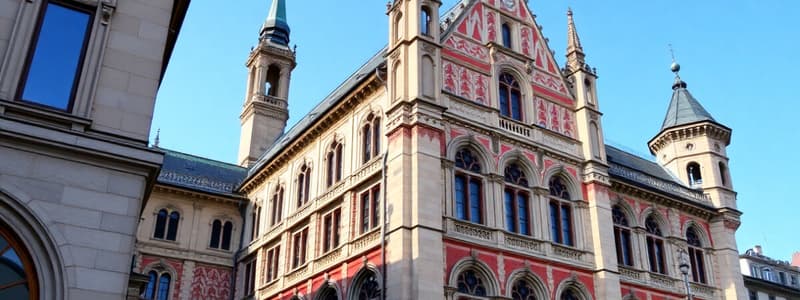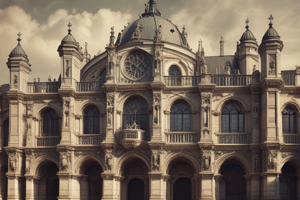Podcast
Questions and Answers
What architectural feature is predominantly associated with Roman architecture?
What architectural feature is predominantly associated with Roman architecture?
- Post and lintel system
- Barrel vault
- Round arch (correct)
- Gothic spires
Which characteristic is associated with Greek architecture?
Which characteristic is associated with Greek architecture?
- Heavy ornamentation
- Use of elaborate sculptures
- Curved structures
- Simplicity of detail (correct)
H.H. Richardson is notably linked to which architectural style?
H.H. Richardson is notably linked to which architectural style?
- Romanesque Revival (correct)
- Victorian Gothic
- Baroque
- Modernist
How did Romanesque architecture achieve equilibrium?
How did Romanesque architecture achieve equilibrium?
What was a defining characteristic of architecture during the 'industrial depression' period?
What was a defining characteristic of architecture during the 'industrial depression' period?
What influence did French chateaux have during the Renaissance Revival?
What influence did French chateaux have during the Renaissance Revival?
What material was crucial for the engineering of large spans in Roman architecture?
What material was crucial for the engineering of large spans in Roman architecture?
What aspect of Roman architecture reflects its pretentious nature?
What aspect of Roman architecture reflects its pretentious nature?
What major issue influenced the architecture of the 20th century related to transportation?
What major issue influenced the architecture of the 20th century related to transportation?
How did social structure impact architecture according to the provided content?
How did social structure impact architecture according to the provided content?
Which of the following represents a characteristic of the Greek phase of architectural development?
Which of the following represents a characteristic of the Greek phase of architectural development?
What was a defining feature of Victorian architecture?
What was a defining feature of Victorian architecture?
In what way did the Renaissance phase influence architecture?
In what way did the Renaissance phase influence architecture?
What concept does 'Architecture as an Ideal' primarily relate to?
What concept does 'Architecture as an Ideal' primarily relate to?
What aspect of architecture does 'Architecture as Fine Art' emphasize?
What aspect of architecture does 'Architecture as Fine Art' emphasize?
Which of the following correctly describes the Archaic phase of architectural development?
Which of the following correctly describes the Archaic phase of architectural development?
What is the primary focus of architecture as an art form?
What is the primary focus of architecture as an art form?
Which of the following best describes emotional needs in architecture?
Which of the following best describes emotional needs in architecture?
What distinguishes architecture as a science?
What distinguishes architecture as a science?
How are fundamental impulses related to architecture classified?
How are fundamental impulses related to architecture classified?
What role does architecture play in reflecting human needs?
What role does architecture play in reflecting human needs?
Which of the following is categorized under intellectual needs in architecture?
Which of the following is categorized under intellectual needs in architecture?
Which aspect is NOT considered a characteristic of architecture as an art?
Which aspect is NOT considered a characteristic of architecture as an art?
Which of these pairs best captures the relationship between architecture and human needs?
Which of these pairs best captures the relationship between architecture and human needs?
What are the three primary elements of architecture according to Vitruvius?
What are the three primary elements of architecture according to Vitruvius?
What does 'Firmitas' signify in architecture?
What does 'Firmitas' signify in architecture?
Which of the following represents a modern man's physical needs in architecture?
Which of the following represents a modern man's physical needs in architecture?
What does architectural theory primarily focus on?
What does architectural theory primarily focus on?
How did primitive man adapt his shelter compared to modern man?
How did primitive man adapt his shelter compared to modern man?
Which factor is NOT essential to the structure of architecture?
Which factor is NOT essential to the structure of architecture?
What is the role of social conditions in architecture?
What is the role of social conditions in architecture?
Which statement best relates to the concept of 'Venustas' in architecture?
Which statement best relates to the concept of 'Venustas' in architecture?
What characteristic is associated with a vertical line in architecture?
What characteristic is associated with a vertical line in architecture?
Which line type is described as having a graceful and sensitive nature?
Which line type is described as having a graceful and sensitive nature?
What does a horizontal line symbolize in the context of architecture?
What does a horizontal line symbolize in the context of architecture?
Which characteristic is primarily associated with diagonal lines in architecture?
Which characteristic is primarily associated with diagonal lines in architecture?
Which type of line is described as sturdy and masculine?
Which type of line is described as sturdy and masculine?
What is the defining characteristic of a plane in architecture?
What is the defining characteristic of a plane in architecture?
Which description best fits a horizontal line in architectural design?
Which description best fits a horizontal line in architectural design?
In architectural design, how are curved lines perceived?
In architectural design, how are curved lines perceived?
Flashcards are hidden until you start studying
Study Notes
Architectural Styles
- Greek architecture is characterized by simplicity, clarity, and strength. Notable features include temple and theatre architecture, post and lintel construction, and refinement of lines with minimal detail.
- Roman architecture is known for its magnificent temples, palaces, and baths constructed with concrete vaults and arches. It is also known for its use of the round arch, pier construction, and elaborate ornamentation.
- Romanesque architecture emphasizes the use of the round arch and vault to create equilibrium and stability within its structures. It features direct and vigorous arrangements of mass and detail with a focus on honesty in the use of brick and stone.
- Gothic architecture is characterized by soaring heights, pointed arches, stained glass windows, and intricate decorative details. It is a style that emphasizes verticality and aspiration.
- Renaissance Revival architecture draws inspiration from the classical architecture of ancient Greece and Rome. It brought back the focus on order, symmetry, and proportion that was lost during the Gothic period. The design of mansions owned by wealthy individuals was heavily influenced by French chateaux architecture.
- Romanesque Revival architecture was spearheaded by H.H. Richardson. It is characterized by bold and massive details, often incorporating elements of Romanesque architectural styles.
- Late Victorian/Industrial architecture, known as "Eastlake" style or Victorian Gothic, resulted in buildings with meaningless turrets, gables, and intricate ornaments that lack structural purpose. It can be considered a style influenced by the period of industrial depression.
Architecture as a Response
- The 20th century saw the emergence of new social structures. The rise of the automobile, movies, and radio all played a significant role in shaping architecture.
- Architecture as a response to social needs:
- Shelter: With increasing industrialization and urbanization, the need for proper housing away from workplaces became crucial.
- Traffic problems: Housing layouts were designed to accommodate increased traffic.
- Complex social systems: Development of housing solutions, recreational facilities, and social adjustments were essential to address increasingly complex social structures and issues such as congestion in cities.
- Architecture as defense:
- Developments in urban planning and defensive architecture emerged as a response to organized cities. This involved designing buildings that incorporated strategies for defense.
- Architecture as an ideal:
- Architects aimed to create utopian environments, which resulted in a renewed focus on architectural theory and a return to classical principles.
- Architecture as fine art:
- It became a means of self-expression for evolved societies and was considered a symbol of social status.
Architecture as an Expression of Human Personality
- Greek: Simple, flowing robes reflect a sense of scholarly and philosophical refinement. Athleticism was vital, reflected in the design's focus on the body and health. Greek architecture emphasized purity of detail and technical skill.
- French Renaissance: Multiplicity of details in court life, dress, and architecture. The era showcased a complicated social etiquette and an artificial, theatrical lifestyle. Architecture featured elaborate ornamentation.
- Victorian: An era associated with ornate but often considered ugly and monotonous. The focus was on variety in designs.
The Phases of Development
- Archaic: Early efforts to master new techniques, materials, and forms. This includes prehistoric, Mesopotamian, and Egyptian architecture.
- Mastery: Architects reached a level of proficiency in their craft, resulting in distinct styles and sophisticated techniques.
The Primary Elements of Form
-
I. Needs and Interests of Man:
-
A. Physical Needs:
- Primitive Man: Basic shelter to protect from the elements and wild animals. Structures were small with limitations for space and ventilation.
- Modern Man: Comfortable, dry housing with sanitation, permanent structures, proper ventilation, and access to amenities like electricity, running water, etc.
-
B. Emotional Needs:
- Basic Needs (Utilitarian): Basic survival needs such as food, clothing, shelter, and social structures like government and religion.
- Emotional Needs (Decorative Art): Artistic expressions such as sculpture, painting, music, literature, and ultimately ARCHITECTURE.
-
C. Intellectual Needs:
- Tangible: Material needs associated with food, clothing, shelter, and transportation.
- Intangible: Information and knowledge acquired through education, science, law, medicine, and design.
-
The Influence Of Nature
- Architecture reflects the natural world's influence through:
- Articulate edges and surfaces: Shapes and forms inspired by structures found in nature.
Characteristics of Lines
- Straight Line: Sturdy, masculine, associated with architecture, evoking various moods: pride, exaltation, and inspiration (vertical), calmness and peace (horizontal), and vigor or anger (diagonal).
- Curved Line: Gracious, sensitive, feminine, associated with architecture that caters to emotional rather than physical needs.
The Plane
- Plane: An extended line, characterized by length and width. It defines the boundaries of a volume. It can have different shapes, colors, patterns, textures, orientations, and positions. Its primary characteristic is its form.
Studying That Suits You
Use AI to generate personalized quizzes and flashcards to suit your learning preferences.




